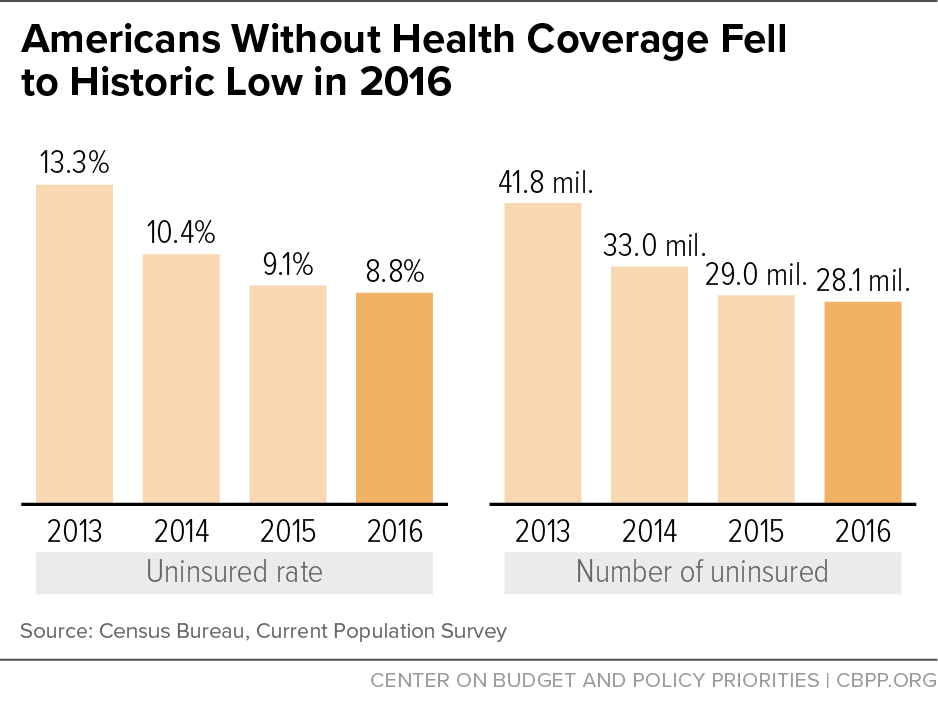BEYOND THE NUMBERS
The share of Americans without health insurance fell to an historic low in 2016, the Census Bureau’s new Current Population Survey (CPS) data show. In 2016, the third full year that the Affordable Care Act’s (ACA) major coverage expansions were implemented, the large coverage gains that the ACA has generated continued to grow. Some 8.8 percent of people lacked insurance in 2016, down from its 2015 rate of 9.1 percent and down more than one-third from the 2013 rate of 13.3 percent. Also a historic low, 28.1 million people were uninsured in 2016, more than 900,000 fewer than in 2015 (see chart).
The 2016 uninsured rate and number were record lows (with data that date back to 1997) and the number of uninsured has fallen by 20 million since 2010 when the ACA’s first provisions went into effect, based on data from the Centers for Disease Control and Prevention’s National Health Interview Survey (NHIS). While the new CPS data are considered the gold standard for national-level health coverage estimates, it’s necessary to use NHIS data for longer-term trends due to technical changes in the CPS data over time. Results based on the NHIS, however, are highly consistent with those based on the CPS.
Today’s CPS data also show that the share of Americans enrolled in public coverage rose from 34.6 percent in 2013 to 37.3 percent in 2016, while the share with private coverage rose from 64.1 percent to 67.5 percent. The growth in public coverage was due to the ACA’s Medicaid expansion and the further aging of baby boomers into Medicare eligibility. The growth in private coverage occurred in individual market coverage (while employer-sponsored coverage remained flat), likely reflecting the ACA’s subsidies to help people with modest incomes buy coverage through the health insurance marketplaces.
While the uninsured rate fell for the overall population, certain groups experienced particularly big declines in 2016:
- Young adults aged 19 to 25, from 14.5 percent to 13.1 percent.
- Part-time workers, from 15.8 percent to 14.8 percent.
- Non-Hispanic whites, from 6.7 percent to 6.3 percent.
A growing body of research highlights the significant short- and long-term benefits of health coverage for the uninsured. For example, studies show that Medicaid coverage expands access to health care providers and services, improves health, increases preventive care and screenings, and reduces financial hardship. It also improves children’s long-term educational outcomes and earnings as adults.
Similarly, the Commonwealth Fund finds that more than 7 of 10 adults with marketplace coverage used it to visit a provider or fill a prescription — and 61 percent of them said they couldn’t have obtained this care without the marketplace coverage.
This historic progress in expanding health coverage, however, is in serious jeopardy. The Trump Administration continues to take steps to seriously weaken the marketplaces and destabilize the overall individual market. Moreover, while leading members of Congress, with the help of governors and insurance commissioners, are now working on bipartisan legislation to strengthen the individual market, some in Congress, like Senators Bill Cassidy and Lindsey Graham, continue to pursue damaging legislation that would repeal and replace the ACA and thus increase the ranks of the uninsured by tens of millions. Policymakers should instead focus on building on the ACA’s gains, enabling more people to get covered.

